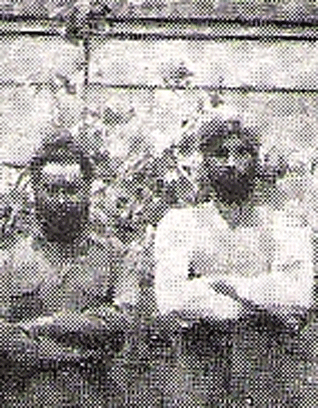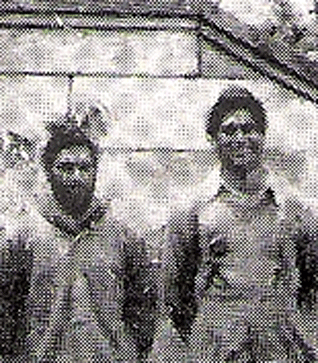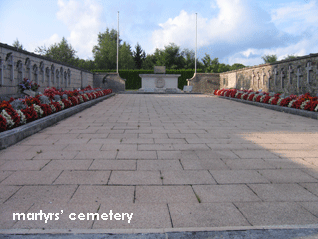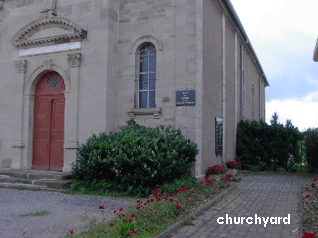History
Etobon: Succour & Refuge for Sikh Soldiers During WWII
by KATHERINE DOUGLASS
In May, 1944, as the final invasion for the liberation of Europe approached, a little-known episode in World War II history was unfolding in eastern France.
As part of their campaign to destroy German positions, the Allies bombed the city of Epinal, in the Vosges region of France. One of the targets of that bombing was a German prisoner of war (POW) camp that held Allied soldiers. Among them were British troops from India, including many Sikh soldiers, who had been captured at Tobruk in North Africa.
Once the prison camp had been destroyed, the prisoners had to flee the Germans or be recaptured and executed or imprisoned. These prisoner-soldiers were on the run in occupied France, part of the Nazi empire in Europe. Their only hope for sanctuary was to reach Switzerland, a neutral nation, where they could remain until the end of the war, or seek repatriation to India or Britain.
The problem for these soldiers was that they were miles from the Swiss frontier, in a rural region of forests, isolated villages and farms. Their skin color and clothing would easily identify them to passing German patrols or collaborating villagers. Although their British uniforms were well-worn by the time they escaped, many of the Sikh soldiers maintained their identity by wearing turbans and maintaining unshorn hair and beards. If they were to survive to reach Switzerland, they would have to remain hidden and be helped by sympathetic French people.
This is a true story of the end of World War II in Europe. This article is based on accounts of what happened in the villages of Etobon and Chenebier in the spring and summer of 1944. These accounts are recorded in journals kept by witnesses and come from personal communications from the witnesses and their descendants to the author.
More information, photos, and background can be found at etobonstory.squarespace.com.
The escaped soldiers, including Sikh, Hindu and Muslim men, as well as a few Chinese and Tibetans and at least one Canadian Native American, began to appear near Etobon sometime around Sunday, May 14, 1944.
The village blacksmith and vice-mayor, Jules Perret, records in his diary that he met six men that evening, all of them barefoot
and dressed in rags. Over the next weeks, by two's and three's, and sometimes up to nine or ten at a time, made their way to the village and its surrounding farms. Over the following weeks over 100 escaped prisoners passed through Etobon. The French provided food, clothing, and shelter in barns, cellars and attics, as the soldiers arrived.
Some of the groups were taken to shelters in the surrounding woods, the Wolf Mill and Isaac's Mill. But the villagers of Etobon knew that they could not hide large numbers of these men for long: they were too conspicuous, and food was becoming scarce.
The men of Etobon had been loosely organized into a group of maquis, or rural resistance. Although they were poorly armed, mostly with pre-war guns and hunting rifles, the British had been providing explosives by means of nighttime airdrops. The
maquis of Etobon were specialists in sabotage of rail, telephone and electric lines. They were in contact with the maquis of surrounding villages, especially the village of Chagey, situated on the other side of a private forest.
As the Sikh and other Indian soldiers began to arrive, the maquis of Etobon, conferring with their leader, the Lutheran Pastor Marlier, devised a plan to deliver the soldiers to the Swiss frontier by handing them off from village to village by way of the Chagey maquis.
For the first few weeks, the plan was successful. The maquis of Etobon would disguise their prisoners as French farmers, complete with scythes and rakes, and escort them through fields and woods to meet the Chagey maquis. From there, other maquis would escort them to the frontier of Switzerland, near the villages of Delle and Beaucourt, about 15 miles from Etobon.
It was not long before the Germans discovered groups of these prisoners as they tried to enter Switzerland. Patrols along the frontier were increased, many of the escaped prisoners were killed, and many others turned back. Several returned to Etobon.
For the next six months, during the bitter end of the occupation of France, the people of Etobon sheltered these soldiers, hiding them in the woods, helping them to build shelters and camps, and providing food and clothing to them.
As the Germans fled from the Allied invasions to the west and south, they became more and more ruthless with the people of eastern France. The village of Oradour was razed, and all its inhabitants locked in the village church as the church was burned. Many resistance and maquis were executed or deported to concentration camps. At Etobon, the maquis had joined with a group of national police (gendarmes) who had left their posts to fight the occupiers.
Emboldened by the success of their sabotage and guerilla activities, the maquis began to take German prisoners and hide them in their camps in the woods. German patrols, in return, began searching and raiding the more obvious hiding places,
such as the old mills.
One of those German prisoners held by the maquis, Gunther Ulrich, escaped and found his way back to a German unit. He was able to identify the active maquis in the village, and corroborate that the Etobon maquis had been involved in an attack on a German convoy in which German soldiers and officers had been killed.
The German convoy was attacked on September 9, 1944. Jules Tournier, the field commander of the maquis, was shot and killed. Two weeks later, on September 27, the Germans exacted their complete revenge on the people of Etobon.
At 8 o'clock on Wednesday morning, September 27, 1944, the village crier called all the men of the village between the ages of 16 and 60 to assemble at the school, in the center of the village, across from the Lutheran church. Ulrich was there, pointing out members of the maquis to the commanding officer. Seventeen were identified as "suspects."
The men were told they were being taken to the nearby town of Héricourt to dig entrenchments. A few were able to slip out of back doors and hide from the Germans. One hid all day in a woodpile, another in the church steeple and a few hid in barns or
attics. Sixty-seven men, including Pastor Marlier, were marched away from Etobon by the Germans that day. As the men started to walk the few kilometers towards the neighboring village of Chenebier, German shells began to fall on the village.
When the men of Etobon reached Chenebier, at about 12:30 p.m., they were locked inside an abandoned sewing factory near the Lutheran church. They were interrogated and some were beaten. Another escaped German prisoner, Karl Lade, chose 23 more men from among the 67, to make an even 40 along with the 17 "suspects." The remaining 27 were loaded onto wagons and taken in the direction of the city of Belfort.
Just after 4 p.m., the 40 men of Etobon who remained were told they would be shot. The outside wall of the Lutheran church was chosen as the place of execution. Ten by ten, the men were led out and machine-gunned as they stood or kneeled in front of the wall.Many chose to sing or whistle the French national anthem, La Marseillaise, as they died.
One of the men, Philippe Kuntz, was released just as it was his turn to face the machine gun. The executioners have been identified as: Colonel Vonalt, Major Bachmayer and Dr. Rudy Rauch, the officers, and the machine-gunner Pietro-Pilot, a Sicilian. An unnamed SS officer used a rifle to finish off any of the men who survived the machine gun.
Thirty-nine men were massacred that day against the wall of the church. Of the 27 who were taken away, seven were shot in the nearby town of Banvillars ten days later, and the others, including Pastor Marlier, were sent to concentration camps. Marlier was deported to Buchenwald, and was able to survive his captivity and return to Etobon in 1945.
The village of Etobon continued under bombardment in the days following the massacre. Word of the death of most of the men of the village did not reach home until several days later. In the weeks and months until the liberation of the village on November 18, 1944, the people of Etobon were harassed, bombarded and nearly starved. They continued, though, to help those whom they had hidden.
One soldier, Daya Ram, a sergeant with an artillery regiment, was ill with tuberculosis. The Bonhotal family, who lived on the edge of the woods in Chenebier, took him into their home to care for him, and he died there on October 15, 1944. His body was taken from the house at night, loaded onto a wagon and covered with potato sacks to avert suspicion. He was buried in the woods until his body could be moved to the protestant cemetery after the village was liberated.
In reports at the time of the liberation, there were still Indian soldiers living in the woods, the Sikh soldiers continuing to maintain their traditions as best they could.
After the liberation of France, the bodies of the 39 men were exhumed from the mass grave in which the Germans had ordered them buried and moved to a cemetery just outside Etobon. The burial place of the seven who died at Banvillars was located and their bodies were also returned to Etobon. A mass funeral was held for the men on Saturday, December 9, 1944. The people of Great Britain helped fund the completion of the cemetery. A plaque donated by the Protestants of Great Britain reads:
"Moved by the terrible sufferings and the bloody sacrifice made in 1944 by the people of Etobon and Chenebier for helping escaped Indian and British prisoners, and for sheltering feeding, hiding and guiding them to the Swiss border, the Protestant of Great Britain have placed this plaque in witness of their admiration and gratitude. There is no greater love than to give up one's life for one's friends."
The Government of India has provided two plaques: one in French and one in Hindi. They read: "Witness of the gratitude of India to the citizens of Etobon and Chenebier for the aid given to Indian prisoners of war. India grieves for the noble sons of these two villages, who gave their lives for the common cause."
About the prisoners
The soldiers were variously described as wearing turbans or having "long hair like a woman's." Others were said to refuse pork, and some to refuse any meat. Based on these observations, it seems that the prisoners must have included Sikhs, Muslims and Hindus.
Have you heard of this story from a family member who was a WWII veteran? We are looking for survivors or their descendants who might have been a part of the group sheltered in Etobon. If you have any information, please contact us via the Comments section.
[Article & photos: Copyright - Katherine Douglass]
July 12, 2010
Conversation about this article
1: N. Singh (Canada), July 12, 2010, 12:48 PM.
What a moving and touching story! Goodness lives in all people, regardless of their race, religion and colour. We are grateful to those who sacrificed their lives. May God bless their souls and may they rest in peace.
2: Bibek Kaur (Liverpool, United Kingdom), July 12, 2010, 5:43 PM.
Thank you for rescuing this story from oblivion and recording it for posterity. It honours the soldiers who gave so much of themselves in fighting and sacrificing for the benefit of the Allies, and it honours the resistance fighters who also risked their all and laid down their lives as well. The world is a better place because of all of them. Thank you, Ms. Douglass for this great service you have done to their memory, and for us.
3: Scott K Dolik (McCall, Idaho, USA), May 29, 2018, 1:56 AM.
My great great grandmother was born in Etoban, France as Mary Guyman and is buried in North Dakota USA. She is in a very lonely cemetery with about seven others. The church burned down years ago but a farmer has maintained the cemetery. Two of the martyrs on the wall in Etoban were named Gueman and I an certain they are kin to my great great grandmother. I feel so pleased that they opposed the Nazis and helped the Sikh soldiers in their time of need. I am sorry they lost their lives but am glad they were on the side of good. God Bless you all.






